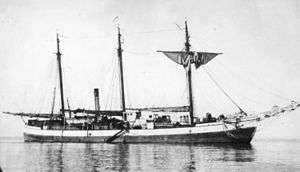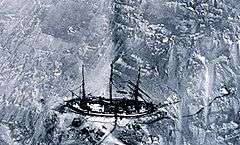Gauss (ship)
 The CGS Arctic at anchor at Pond Inlet, 1923 | |
| History | |
|---|---|
| Name: | Gauss |
| Namesake: | Carl Friedrich Gauss |
| Builder: | Howaldtswerke-Deutsche Werft, Kiel |
| Cost: | 500,000 marks |
| Launched: | 2 April 1901 |
| In service: | 1901 |
| Out of service: | 1903 |
| Fate: | Sold to Canada, 1904 |
| Name: | Arctic |
| Acquired: | by purchase, 1904 |
| In service: | 1904 |
| Out of service: | 1925 |
| Fate: | Abandoned, 1925 |
| General characteristics | |
| Type: | Polar exploration vessel |
| Displacement: | 1,442 long tons (1,465 t) |
| Length: | 46 m (150 ft 11 in) |
| Beam: | 11 m (36 ft 1 in) |
| Draught: | 4.8 m (15 ft 9 in) |
| Ice class: | A1 |
| Propulsion: | 1 × 325 hp (242 kW) auxiliary triple expansion steam engine, single screw |
| Sail plan: |
|
| Speed: | 7 knots (13 km/h; 8.1 mph) |
| Capacity: | 700 tons of stores |
| Crew: | 30 |
Gauss was a ship built in Germany specially for polar exploration, named after the mathematician and physical scientist Carl Friedrich Gauss. Purchased by Canada in 1904, she was called the CGS Arctic.
Ship construction
The ship was built by the Howaldtswerke-Deutsche Werft shipyard at Kiel[2] at a cost of 500,000 marks.[3] Launched on 2 April 1901[1] she was modelled on Fridtjof Nansen's ship Fram, and rigged as a barquentine.[4] Displacing 1,442 tons,[5] the ship was 46 m (150 ft 11 in) long, 11 m (36 ft 1 in) in the beam, with a draught of 4.8 m (15 ft 9 in).[1] With a 325 hp (242 kW)[3] triple expansion steam engine to augment the sails, she was capable of 7 knots (13 km/h; 8.1 mph),[1] Classed "A1" by Germanischer Lloyds, she was designed to carry 700 tons of stores, enough to make her self-sufficient for up to three years with a crew of 30 aboard. The hull was exceptionally strong, and the rudder and propeller were designed to be hoisted aboard for inspection or repairs.[2]
Ship history

Between 1901 and 1903 the Gauss explored the Antarctic in the Gauss expedition under the leadership of Erich von Drygalski.
In early 1904 the ship was purchased by the Canadian government and renamed Arctic. Under the command of Joseph-Elzéar Bernier she explored the Arctic Archipelago. On 1 July 1909, Bernier, without government approval, claimed the entire area between Canada's eastern and western borders all the way to the North Pole.[6] The ship was eventually abandoned in 1925 and left to rot at her moorings.[1]
References
| Wikimedia Commons has media related to Gauß (ship, 1901). |
| Wikimedia Commons has media related to Arctic (ship, 1901). |
- 1 2 3 4 5 "Expeditionsschiff (Barkentine) Gauss". schiffe-und-mehr.com (in German). 2012. Retrieved 3 August 2012.
- 1 2 Appleton, Thomas E. (2012). "Usque Ad Mare - The Last Phase of Wooden Shipbuilding". Canadian Coast Guard. Retrieved 3 August 2012.
- 1 2 "German National Antarctic Expedition 1901-03". coolantarctica.com. 2012. Retrieved 3 August 2012.
- ↑ Mill, Hugh Robert (1905). "Chapter XX: Early Expeditions of the Twentieth Century". The Siege Of The South Pole : The Story of Antarctic Exploration. Retrieved 3 August 2012.
- ↑ Stephenson, Robert B. (2010). "Antarctic Ship". antarctic-circle.org. Retrieved 3 August 2012.
- ↑ MacEachern, Alan (2010). "J.E. Bernier's Claims to Fame" (PDF). Scientia Canadensis: Canadian Journal of the History of Science, Technology and Medicine. Ottawa: Canadian Science and Technology Historical Association. 33 (2): 43–73. doi:10.7202/1006150ar. ISSN 0829-2507. Retrieved 3 August 2012.